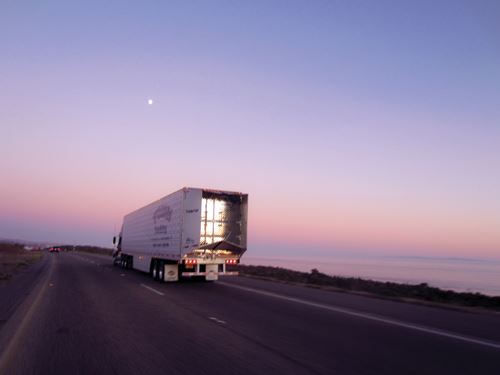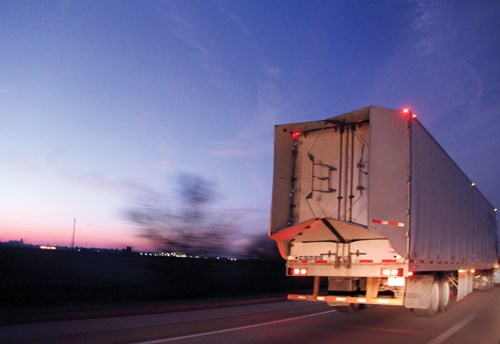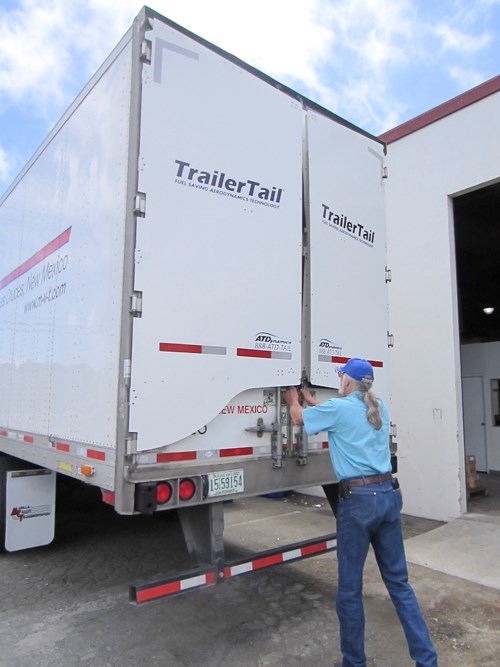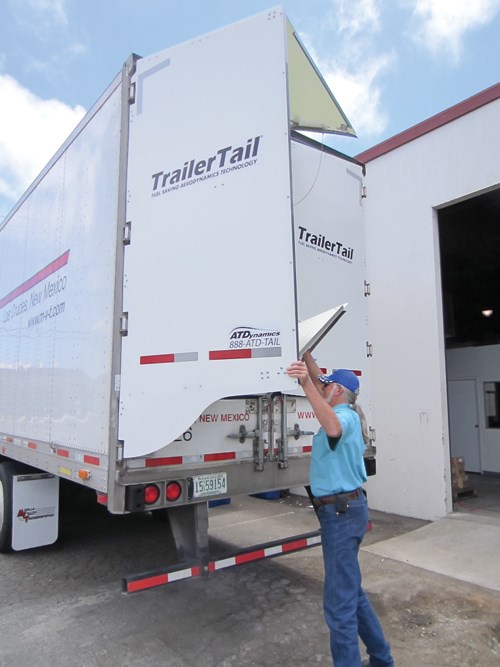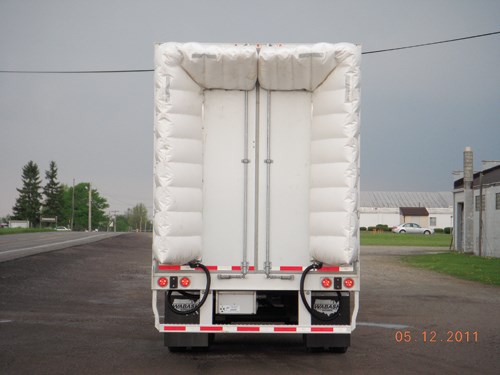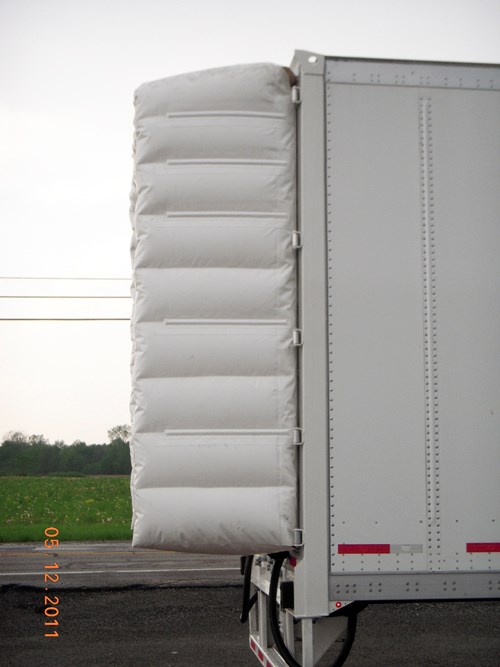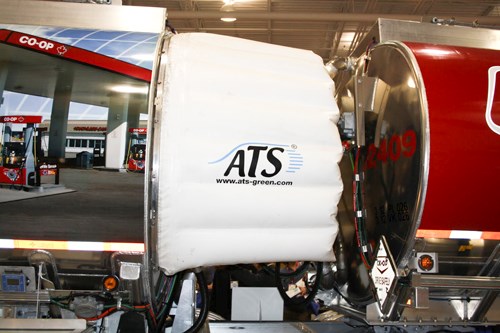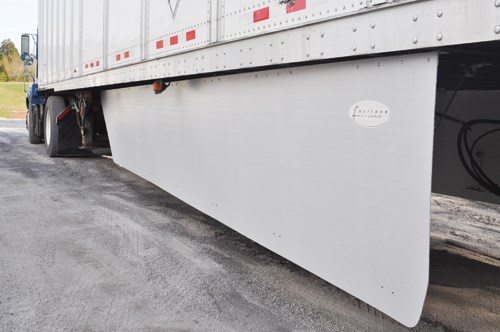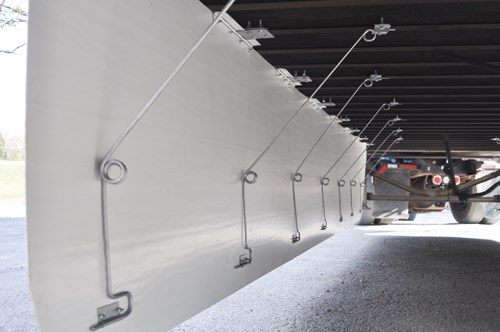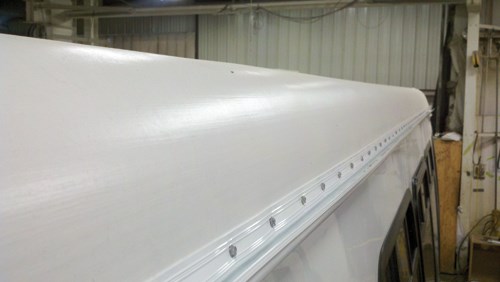Commercial trucking: Streamlining the Big Box
Glass fiber-reinforced thermoplastics help commercial trucking industry optimize weight, fuel and cost savings.
Mandated fuel efficiency goals and tailpipe emissions restrictions pose a significant challenge to the entire auto industry, but for those who build commercial trucks, the cost of ownership looms just as large. Every kilogram of mass removed from a tractor or trailer saves fleet managers and individual owner/operators money on fuel or allows them to carry more product per load while remaining under legal load limits. Similarly, box-like trailers are drag magnets on the open highway. Improved trailer aerodynamics not only saves fuel but also reduces emissions, a critical benefit in locales where the cost of noncompliance can put OEMs and their customers out of business. Truck owners, then, have a strong financial incentive to pressure truck and trailer OEMs to reduce weight and improve fuel efficiency. Composites increasingly provide solutions for both and bring with them secondary benefits that include dent- and corrosion-resistance, noise damping, reduced maintenance and prolonged use life — all of which have a direct, positive impact on a trucker’s bottom line.
A lighter, tougher box
Composite scuff bands and sidewall/floor liners are well-established means to protect metal floors and interior walls of long-haul trailers from forklift, pallet and cargo damage. There also is a trend toward replacing metal exterior sidewalls on trailers with composites.
Polystrand Inc. (Englewood, Colo.) is one supplier of materials for trailer liners, scuff bands and subfloors. Typically produced from unidirectional (UD) glass-reinforced thermoplastic tapes (in 0° or 0°/90° orientations) consolidated into thin, multi-ply, monolithic sheet stock, Polystrand’s continuous-fiber reinforced thermoplastics (CFRTPs) range from 4 to 10 layers thick, can be postformed, and offer trailer manufacturers the opportunity to reduce weight, compared to metals and thermoset composites, without sacrificing stiffness or strength, as well as optimize chemical and impact resistance. Depending on the application, either E-glass or S-glass is used. PPG Industries Inc. (Pittsburgh, Pa.) is the preferred fiber supplier. According to Todd Hobbs, Polystrand’s sales and marketing manager, PPG’s new TUFRov 4588 E-glass fiber works very well with Polystrand’s resin systems. He credits PPG with developing a custom grade of glass fiber and a sizing that meets the needs of Polystrand’s trailer industry customers.
Polystrand uses proprietary matrices, based on either polypropylene (PP) or polyethylene (PE), or a blend of the two, with a UV-stabilization package that provides long-term durability and weatherability when trailer doors stay open for extended periods. A variant for refrigerated trucks (reefers) features foam backing that provides extra insulation. Hobbs say Polystrand has explored other matrices, including polyethylene terephthalate (PET) and polyamide (PA) 6 and 6/6, which customers in several industries are sampling. The sheeting is supplied in large rolls — up to 10-ft wide (3.1m) by 1,600 to 3,300-ft long (488 to 1,006m) — that weigh as much as 4,000 lb/1,814 kg. The materials are cut to length by Tier I suppliers or trailer OEMs, who then add a cosmetic film to the face side (the olefin polymers’ broad chemical resistance also makes them challenging to paint). Customers also add a nonwoven layer to the sheet’s backside to enhance its adhesion to foam.
In Elkhart, Ind., TekModo LLC’s CEO, Marc LaCounte, reports that his company has teamed with Allied Composite Technologies LLC (ACT, Rochester Hills, Mich.) to develop a mix of new products for smaller Class 3-6 trucks and commercial buses. These include thermoplastic sheet materials that feature 0°/90° tape and a PP matrix in a sandwich construction with a honeycomb or foam core, and are designed to replace wood in trailer floors. At only 1.125 inches/28.58 mm thick, the panels reportedly can withstand forklift loads.
Of potentially greater impact, LaCounte says, the two companies are developing an insulated thermoset sandwich composite to replace reefer exterior sidewalls that are now made from twin sheets of steel with a foam core. Tekmodo says the new product is much lighter than the metal system, and it uses a unique glass-reinforced oxysiloxane-based ceramic resin that is UV-stable, impact-resistant and nonflammable. Further, it can be highly loaded with glass, or it can be foamed to make a lightweight insulated panel. TekModo expects to be the first volume convertor to use the resin and says it will have prototypes on trailers for evaluation by mid-2013.
A whale of a difference
Trailer aerodynamics are of great interest, and one feature that’s gaining in popularity is the rear-drag reduction device (variously called a boat tail, whale’s tail or spoiler). There are several commercial or near-commercial variants for long-haul (U.S. Class 8) trailers. They mount along the top and outside edges of rear doors to help transition the air that sweeps across the trailer’s top and sides toward the end of the unit, and would otherwise begin to swirl around and create large, standing vortices that increase drag.
An established system is Advanced Transit Dynamics Inc.’s (ATDynamics, Hayward, Calif.) trademarked TrailerTail. This composite device, which was introduced in 2007, is now on the road aboard 13,000 trailers in North America. Certified to provide 6.6 percent fuel efficiency gains (a savings of $0.03/mile or almost $0.02/km), based on the Society of Automotive Engineers (SAE) International’s (Warrendale, Pa.) SAE Type II testing, the system also is said to be sufficient for standalone compliance with 2010 California Air Resources Board (CARB) regulations. Given that most trailers average 50,000 miles/80,467 km per year and have a useful life of 15 to 20 years, ATDynamics says the small savings add up and claims the unit will pay for itself in less than a year at current fuel prices.
Beyond fuel efficiency, the unit offers increased trailer stability (particularly during lane changes), reduced road spray (for vehicles following the trailer) and improved rear visibility and sightlines for the driver, who, without the device, would see a swirling cloud off the back of the trailer during rainfall or snowstorms.
A “linked origami structure” (self-contained folding device), optimized during 25 million miles/40 million km of testing with fleet development partners, the system is mechanically attached to each rear door. Standard panels for the U.S. market are 4-ft/1.2m deep when open and reportedly are exempt from U.S. Department of Transportation (DoT) length restrictions.
The panels are formed from sheetstock (UD glass-reinforced PP, PE or a blend of the two) from several unnamed suppliers. ATDynamics cuts out top and side panels for each door, plus two smaller panels a few feet from the bottom of the doors that form a reversed V-shape when deployed to further reduce turbulence. A variety of metal latches, mounting plates, springs and patented metal swing arms link the panels so the entire structure opens and then collapses and latches out of the way as a unit. The patented design, however, necessitated a number of material changes early in the program.
“When we started out, we looked at aluminum honeycomb and other sandwich panels, but there was too much stack-up, since three panels fold on top of each other on each door when the system is closed,” explains Jeff Grossmann, engineering VP at ATDynamics. When the doors were fully opened and secured, the combined spoiler panels, when they were made of thermoset composites or metal honeycomb, were too thick to fit in the less than 1-inch/25-mm gap between the door and the trailer sidewall. “That meant we had to make modifications to the trailer doors on our original prototypes.” Ultimately thermoplastics offered sufficient structural properties in a 0.125-inch/3.18-mm thick panel. “So we no longer need to make trailer modifications,” he says, adding, “That was one of many design leaps that led to our system being installed on so many trailers.”
The TrailerTail latch is similar to those used on car doors. A simple one-handed pull on a release cord manually deploys the unit, which is naturally biased to open outward. Deployed panels have a slight curvature that increases their rigidity. Computational fluid dynamics (CFD) analysis and wind-tunnel testing helped ATDynamics arrive at the current shape and depth. “The most important area for rear-drag aerodynamics is inside that first 4-ft [1.2m] region,” Grossmann explains. “While a theoretical optimal shape might be somewhat longer, the TrailerTail, by far, offers the most bang for your buck. It wouldn’t be worth the extra cost or complexity to make the panels longer,” he says. ATDynamics rolled out a shorter version in November 2012 to address regulatory landscapes elsewhere in the world, particularly in Europe. “While a shorter TrailerTail won’t deliver the same fuel savings as the original 4-ft version, it still provides a way for certain international markets to achieve a much-needed efficiency boost today while length exemptions are under consideration,” says Grossmann.
A potential competing system, trademarked SmartTail, is transitioning from beta testing to commercialization. Built by Aerodynamic Trailer Systems LLC (ATS, Bedford Heights, Ohio), it weighs 130 lb/59 kg, features a controller with a power supply and two blowers — one for inflating the system and another for vacuum evacuation of air — and two L-shaped lobes made of a quilted polymer fabric similar to that used for inflatable domes and trailer side curtains. Each lobe contains baffles (inflatable pockets). The lobes are mounted along the top and outside edges of the trailer’s rear doors with aluminum keder rails. The rails are bolted to the doors. This connection method eliminates the possibility of lobes becoming dislodged during use, yet it provides for easy replacement (by unbolting select rails and sliding off a lobe). Fully inflated lobes taper out to 3 ft/910 mm from the surface of the rear doors. A shorter 2-ft/610-mm version is on the way for international use.
Spoiler deployment requires no driver interaction. Proprietary algorithms in the controller instruct the blower to inflate the lobes when the truck reaches a preset speed. Reportedly, the controller is programmed to inflate the lobes faster if the truck quickly reaches a speed of 50 mph/81 kph or greater; they inflate more slowly if the truck is traveling at lower speeds (e.g., at or above 30 mph/48 kph). If the truck slows down for a few minutes, stops or begins to reverse, the other vacuum blower quickly deflates and holds the lobes flat to ensure they do not impede the driver’s ability to open and secure the rear doors. ATS claims the product improves fuel efficiency by 4 to 7 percent and is maintenance-free. The lobes have a three-year warranty, but ATS predicts they have a 10-year service life.
The composite polymer lobes are formed from tightly woven thermoplastic polyester fabric, which is impregnated with an elastomeric polyvinyl chloride (PVC) resin and top coated with a substance similar to polytetrafluoroethylene (PTFE) to make it airtight. ATS spent a lot of time with several fabric suppliers developing the original sleeve material and is still tweaking the fabric and polymer to refine the system and extend its useful life, notes CEO Jim Domo. The resulting product is a ripstop, stretch- and puncture-resistant, waterproof, leakproof, fire-retardant and flexible membrane. It also provides UV and chemical resistance; it is static-, stain- and shrink-resistant; and it doesn’t support growth of bacteria or mildew. (ATS declined to name its suppliers, but the company purchases the fabric in roll stock and outsources some aspects of part production.) The company says the material’s tensile and tear strength and ductility support inflation and deflation “countless times” in any weather. The topcoat helps the fabric shed water and ice, so there is said to be no buildup in cold weather.
Domo reports that almost 100 SmartTail systems are on the road, under evaluation by several fleets. He claims that the units will pay for themselves, on average, in nine months, based on typical use.
A modified version of the SmartTail, called SmartGap, is rolling out for use on the rear of tankers and between the first and second tanks on tandem-tanker units. The unit is oval or circular in shape and is functionally similar to the SmartTail. Domo says ATS worked closely with Canadian tanker manufacturer Advance Engineered Products Group (Regina, Saskatchewan, Canada) to develop the product, and Advance offers the SmartGap air spoiler as an option for new tanker purchases. The U.S. Environmental Protection Agency SmartWay program lists products from ATS as verified aerodynamic technologies based on track tests performed at Continental Tire’s track at Uvalde, Texas.
Skirting the issue
Another aero trend is skirting, that is, panels or side shields that hang below the long sides of the trailer, between the axles, to reduce crosswinds and under-vehicle turbulence. Reportedly, such panels can help improve fuel efficiency by 6 to 7 percent. Originally aluminum, skirts are shifting to thermoset sandwich panels and, more recently, reinforced thermoplastic sheets or sandwich panels that are similar to the materials used for liners, subfloors and scuff bands.
Polystrand supplies skirting manufacturers with its sheet products. “In this segment, OEMs have not only learned to lighten and stiffen up their liners, but skirts are becoming thinner and much more rigid as well, and that really helps gas mileage,” says Hobbs. “This industry is very competitive, so they’re not saying how they’re doing it, but if you can have something lighter, tougher, faster, then you’re ahead of the game. You’ve got to ask why anyone would use heavy aluminum for an aerodynamic side skirts when they have other options,” he notes. “It just seems contradictory.” Hobbs predicts that skirts and whale’s tails are the future of aerodynamic design in the trucking industry, and he says that Polystrand will be focused on mastering them over the next few years.
TekModo’s skirt, a thin sandwich panel, features faceskins of 0°/90° UD-tape-based composites, which are 50 percent E-glass, by weight, in a PP matrix plus a random glass-mat core with a matrix of PP regrind. The panels are 0.125- to 0.250-inch (3.18-mm to 6.35-mm) thick, including the core. They are protected by Primer 94 from 3M Co. (St. Paul, Minn.), a weather- and UV-resistant olefin film that can be wiped on; it also preps the surface for decals. The film, like the resin matrix, is typically white. The panels are supported by braces and L-brackets that are positioned behind and above the shields. The brackets are spring loaded, so if the trailer rolls over obstructions (such as railroad tracks), the panels bend to relieve stress and snap back, rather than break or shear off. LaCounte says the panels resist damage by road salts, grease and fuel.
Raising the performance ceiling
Another product offered by TekModo is a new thermoplastic sheet for roof membranes that are part of the roofing system. The sheet is formed from PP/glass tapes (0°/90°) and reportedly replaces heavier and less durable thermoset fiberglass composites (unsaturated polyester resin with either continuous or random chopped glass fibers) that are stretched over aluminum or steel roof bows on delivery trucks and dry vans. LaCounte says that traditional fiberglass sheet doesn’t last very long and is prone to cracking and yellowing. The stiffer, thinner, more durable thermoplastic membrane, called CosmoLite sheet, is not molded to shape prior to installation; instead, it is formed onsite. Adhesive is applied to the roof bows, then the flat sheeting is installed, wrapped to fit the roof contour and mechanically fastened in place.
Reportedly, the new product offers an order of magnitude better impact strength and greater UV stability, and a lower coefficient of linear thermal expansion (CLTE) than the thermoset systems it replaces. Additionally, it’s more forgiving of radius bends on roofs that are not flat. CosmoLite was introduced five years ago, and LaCounte says there are currently at least 30,000 units on the road; companies that have installed the system have seen the number of roof warranty claims fall to zero.
Composites keep on truckin’
As tougher emissions and fuel-economy standards approach, expect OEMs and their suppliers to be hard at work, transforming the commercial vehicle industry with a broad range of even more innovative composites on trailers, step vans and trucks.
3M Performance Materials Div.
Related Content
Infinite Composites: Type V tanks for space, hydrogen, automotive and more
After a decade of proving its linerless, weight-saving composite tanks with NASA and more than 30 aerospace companies, this CryoSphere pioneer is scaling for growth in commercial space and sustainable transportation on Earth.
Read MoreCo-molding SMC with braided glass fiber demonstrates truck bed potential
Prepreg co-molding compound by IDI Composites International and A&P Technology enables new geometries and levels of strength and resiliency for automotive, mobility.
Read MoreJeep all-composite roof receivers achieve steel performance at low mass
Ultrashort carbon fiber/PPA replaces steel on rooftop brackets to hold Jeep soft tops, hardtops.
Read MoreASCEND program update: Designing next-gen, high-rate auto and aerospace composites
GKN Aerospace, McLaren Automotive and U.K.-based partners share goals and progress aiming at high-rate, Industry 4.0-enabled, sustainable materials and processes.
Read MoreRead Next
Plant tour: Daher Shap’in TechCenter and composites production plant, Saint-Aignan-de-Grandlieu, France
Co-located R&D and production advance OOA thermosets, thermoplastics, welding, recycling and digital technologies for faster processing and certification of lighter, more sustainable composites.
Read More“Structured air” TPS safeguards composite structures
Powered by an 85% air/15% pure polyimide aerogel, Blueshift’s novel material system protects structures during transient thermal events from -200°C to beyond 2400°C for rockets, battery boxes and more.
Read MoreVIDEO: High-volume processing for fiberglass components
Cannon Ergos, a company specializing in high-ton presses and equipment for composites fabrication and plastics processing, displayed automotive and industrial components at CAMX 2024.
Read More
.jpg;width=70;height=70;mode=crop)
